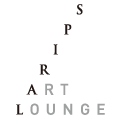Welcome to our ‘spiral market selection’ interview series, where we look at living from the viewpoint of artists and creators engaged in craftsmanship for daily life. In our seventeenth interview, we spoke with Shigeo Akiya, a ceramic artist for whom working with ceramics is like interacting with plants. Read about how he focuses when working with clay.

──Keeping an appropriate distance from the clay
With ceramics, and in particular when it comes to making tableware, some clays work better soft during shaping, while others are better a little firmer. It's not possible to move straight on when you finish one step in the process – you have to let a piece rest at least overnight. I wait as the soil changes and dries before grinding back the base or adding decorative white clay…I need to wait for things to settle in after intervening in some way, always calculating the best timing for the clay.
Just like with plants, the care you give differs by season, so while sometimes you water every day, in winter, once every two or three days is plenty. It’s the same with ceramics: neither I nor the clay is the star. It's about maintaining the perfect distance and touching and manipulating the right amount. At the same time, I’m not simply a bystander – I have an emotional attachment to what I’m making. It’s that point of moving forward that I find similar to raising a plant. Sometimes I really push the clay, but there's a fine line and how far I can go doesn’t just come down to my strengths. I have to step back and think about it. I'm constantly forced to think about nature and natural materials.

──Feeling something simply by looking
After graduating from university, I had a shocking experience when visiting a solo exhibition by Yoshihiko Yoshida an artist who works in Gifu. His focus was tea ceremony utensils, but they were totally different to anything I’d seen before. It's hard to explain, but the mood of the pieces was totally different. Seeing them was my inspiration to start making tableware.
Until then, my education had placed more importance on the conceptual component. We had to explain the concept of our own piece, and then it was inspected and evaluated. So the flow was listening to the concept, reading it and understanding it. But with Yoshida’s works that was totally unnecessary – I felt something by just looking at the pieces. It was such a strange sensation. And I loved it. It made me think, that's what I want to do too.
Later on, during a visit to Yoshida’s studio, I was shown into a parlor filled with all kinds of primitive art and traditional tools from Africa and Southeast Asia. He asked me what I felt, and I remember my answer was “I feel like I’m breathing”. I’ve visited several times since, and he's shown me all kinds of pieces, but I’ll never forget how he said he thought it would be wonderful if my pieces could be like those works of art.

──Feeling “a sense of breathing”
I've been working on my own for about 20 years now. And through all the things I’ve made, the thing I guard most closely is that “sense of breathing” – I don't want to lose that. My recent pieces are simple to the point of minimalist, but if I lose that quality, my works will be no different to mass-produced pieces. My focus is on works in which you can feel that “sense of breathing”.
It's difficult to explain exactly what “sense of breathing” is, but I guess it's about the shape filling out as I spin the potter’s wheel. When making pieces with molds, it’s incredible because I can stop and look at them. But pieces made on a wheel show the rhythm and the breath of the creator. It looks like the clay is being drawn straight up when in fact it is being twisted up. It's like pulling out the core of a piece of paper that's been rolled into a tube. It is being pulled up, but it forms a spiral. It’s the same with the kneading process called “spiral wedging” in which the air is pushed out from the inside as the clay is rolled into a spiral shape. Then the core of the rolled clay is placed on the wheel and pieces are shaped by pulling upwards. Little by little, pulled and twisted into a spiral shape – it's that movement that I really wish to exhibit.
In clay form, a piece has movement that I can see vividly, but as I glaze and fire the piece, it weakens, at times like it’s wrapped in a veil. But if I can just remember and focus on that, the shape actually changes.
One artist I really admire says, “we have a tendency to look at the outline when we create, when we should really be focusing on the inside. The reason some pieces appear stiff is because we try to force them into the framework of our image of the finished piece”. That’s always on my mind now. Just like fruit ripens from the inside, we need to allow a dish to gradually meld into its space from within.
I think I walk a very fine line, but as I create, I contemplate how to make pieces with an outflow, a sense of breathing, but that also fit well into people’s lifestyles.
Interview and editing by Spiral

1991 Graduated from ceramics program of Takasaki Art Center College; apprenticed to Yutaka Nakayama
1997 Set up own studio in Misato City, Saitama Prefecture
Works selected for Youth Exhibition (Gunma Youth Biennale), Nisshin Foods Modern Ceramics Noodle Bowl Grand Prize Winners Exhibition, Asahi Modern Craft Exhibition, Japan Craft Exhibition, East Japan Traditional Crafts Exhibition
Some of the items by Naozumi Tanaka are still available for sale in Spiral Online Store.

Spiral Online Store Shigeo Akiya's special page

Venue:Spiral Market
* The event has ended





